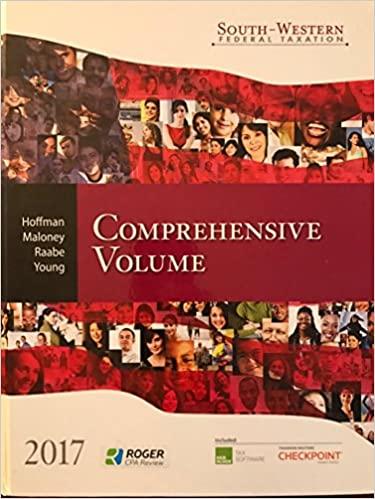Question
Richard gave his wife, Carrie, $100,000 to invest in a new general partnership established by Carrie's friend Sue. According to their partnership agreement, Carrie is
Richard gave his wife, Carrie, $100,000 to invest in a new general partnership established by Carrie's friend Sue. According to their partnership agreement, Carrie is entitled to 40% of the profits and losses of the business; Sue is entitled to 60%. After some time, Carrie lost interest in the business and decided to let Sue have full control of the operation while Carrie worked full-time elsewhere. The business realized a profit of $280,000 in its second year. With respect to the taxation of the profit in the second year, what statement is true?
a) Richard has taxable income of $112,000.
b) Sue has taxable income of $280,000.
c) Carrie has taxable income of $112,000.
d) Carrie has taxable income of $140,000.
Q. Who is NOT technically a related person but, is nevertheless subject to income attribution rules?
a) spouse or common-law partner of a taxpayer
b) brother-in-law or sister-in-law of a taxpayer
c) minor niece or nephew of a taxpayer
d) same-sex, common-law partner of a taxpayer's son or daughter
Q. What is NOT considered a non-capital loss?
a) the full amount of allowable business investment losses incurred in the current year
b) all unused losses from employment incurred in the current year
c) all unused rental losses incurred in the current year
d) all unused business losses incurred in the current year
2. Bessie wants to invest $50,000 in a private corporation currently controlled by her brother, Max. Max would own 60% of the shares; 20 other investors, including Bessie, would own 2% each. Bessie is unsure about what her management role will be. What statement is true?
1. Bessie will become one of the directors of the corporation.
2. The directors must be selected from among the 21 shareholders.
3. Bessie will have the right to vote on any future mergers.
4. Bessie has the right to be involved in the day-to-day management of the business and in the affairs of the corporation.
a) 1 and 3
b) 2 and 4
c) 3 only
d) 4 only
3. Jack operates an accounting practice out of the spare bedroom in his 8-room house. This room is Jack's principal place of business and it is used exclusively for business purposes. Last year, Jack paid $600 for home insurance, $1,400 in utilities, $2,400 in property tax, $5,600 in mortgage principal and $8,900 in mortgage interest. He does not claim capital cost allowance. How much can Jack deduct as a business-use-of-home expense?
a) $250.00
b) $550.00
c) $1,662.50
d) $2,362.50
4. Hope has current taxable income of $240,000 and plans to work for another 20 years. She will continue to be in the top marginal tax bracket for the foreseeable future. Hope is a sophisticated investor with a high risk tolerance. She is seeking a strategy that will decrease her current taxable income. What investment would best suit Hope's objective?
a) an equity mutual fund with a focus on long-term capital appreciation
b) leveraged real estate
c) common shares
d) an interest in a profitable general partnership
5. Marjorie has a modest investment portfolio that contains shares in a mutual fund, a closed-end investment corporation and several public corporations. What type of income will Marjorie NOT receive?
a) capital dividends
b) stock dividends
c) capital gains dividends
d) interest income
6. Dave is the owner of a private corporation called Bluebell Inc. He receives his compensation entirely in the form of dividends; he is not an employee of the corporation. Dave wants to buy a new house so he borrowed $300,000 from Bluebell on the condition that the loan would be amortized over 10 years at an interest rate of 7%. What statement is FALSE?
a) Dave must include the full amount of the loan in his income in the year that he received it.
b) Bluebell cannot deduct the $300,000 from its income in the year that the loan was made.
c) As he repays the loan, Dave can deduct the principal repayments from his personal taxable income.
d) As he repays the loan, Dave can deduct the interest payments from his personal taxable income.
7. Eric is a CERTIFIED FINANCIAL PLANNER professional however, he is of dubious character. He advised one of his clients, Sheila, to overstate her childcare expenses and told her that it was not a major issue considering she did not have to provide receipts when filing her return and that the Canada Revenue Agency rarely checks on these types of expenses. Sheila followed his advice and as a result she reduced her tax owing by $1,200. What statement is FALSE?
a) Sheila has committed tax evasion.
b) Eric may face a criminal penalty.
c) Eric may face a penalty of at least $1,000.
d) Sheila could face both civil and criminal penalties
Step by Step Solution
There are 3 Steps involved in it
Step: 1
The detailed answer for the above question is provided below ANSWER Lets go through each question one by one 1 With respect to the taxation of the profit in the second year what statement is true The ...
Get Instant Access to Expert-Tailored Solutions
See step-by-step solutions with expert insights and AI powered tools for academic success
Step: 2

Step: 3

Ace Your Homework with AI
Get the answers you need in no time with our AI-driven, step-by-step assistance
Get Started


